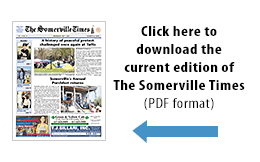(The opinions and views expressed in the commentaries and letters to the Editor of The Somerville Times belong solely to the authors and do not reflect the views or opinions of The Somerville Times, its staff or publishers)
 By Joseph A. Curtatone
By Joseph A. Curtatone
We have 17 food pantries operating in Somerville. When you travel around the city it may not look like local families are suffering the kind of deprivation that would make so many active food pantries necessary, but it is here. Truth be told, it’s in almost every city and town even if it’s not always easily seen. The people living at the bottom of the economic scale can’t keep pace with the cost of living and one of the places that can hurt most is in food access.
In order to get a clear picture of where our community stands in terms of food issues, Shape Up Somerville and the Somerville Food Security Coalition partnered with multiple other organizations to create the Somerville Community Food System Assessment. It provides a complete 360-degree local look at food access and consumption along with an assessment of Somerville’s food economy.
We talk a lot about neighborhood changes, but this report asks how do these changes affect our food system, such as what and where food is sold? What people can afford to eat? How many new jobs are available to give residents more opportunity to earn enough to cover the weekly grocery bill? The assessment answers some of these questions, but it also raises more.
Not surprisingly, we found a strong link between housing distress and food distress. Too many people have to make the choice of keeping a roof over their heads or keeping their and their children’s bellies full. Increasing our affordable and attainable housing stocks can help residents reallocate their budgets, freeing up the money they need to eat a nutritionally complete diet.
We also found pent up demand of people who would like to grow more of their own food. We need to expand spaces dedicated to productive use like community gardens, perhaps even consider high-rise community gardens.
The report shares that about half of Somerville residents live within a 10-minute walk to one of our city’s eight grocery stores (three of which opened within the last two years). Add in small neighborhood markets and nearly all residents can walk to a store selling the ingredients you might need to cook a meal. However, that doesn’t mean our nearest store has all the food we need at a price we can each afford.
Our retail assessment confirmed what most of us already know: what’s available at a food store can vary greatly, and even if stores have the same foods available, the prices can vary too. To understand this more precisely, for the report, we calculated the cost of a standard grocery basket to compare food products at 12 grocery stores (this includes some of the stores on the border of neighboring towns like the Wegman’s in Medford) and nine of the neighborhood markets. The total price of the grocery baskets ranged in price costing in total about $7 more at the most expensive than the least. If your closest store is the most expensive each trip, that can add up to a significant financial strain. Add in that neighborhood markets cost 36% more than full service supermarkets and tend to be the closest options for lower-income neighborhoods and it’s clear why transportation is also a key factor in ensuring food access. You need to be able to get to food you can afford.
So how do we get to places with the prices and items we want? Approximately 25 percent of Somerville households do not own a car, meaning they rely on walking, biking, or paid transportation for grocery shopping. Walking and biking can be made infinitely more difficult in the winter, and none of the MBTA bus lines servicing the city meet both criteria of being reliable (on time 75 percent of the time or more) and frequent (running every 15 minutes or less).
So if your neighborhood doesn’t have a food retailer with affordable, healthy food, you may face challenges getting to one that does. We’ll be considering ways to assist and incentivize neighborhood markets to make them assets for affordable and healthy food. The new Green Line will also not only help us meet our goals around sustainable transportation, but will also increase accessibility to food outlets. But that’s just part of the solution. Good jobs is another.
As a community, we set a SomerVision goal of 30,000 new jobs by 2020—and we’re on our way. For one, our food services sector is growing with new restaurants and food businesses opening around town. Twenty percent of all jobs in Somerville are in the food economy, up from 16% in 2012. But while local food sector workers make more money than their state and national peers, their wages still fall well below median local income levels. That’s why we’re focused on bringing new jobs of every type and level in a range of business sectors. It’s also why we are working to offer workforce development opportunities so our residents can prepare for the best paying jobs.
As a community committed to equity and opportunity for all of our residents, addressing food security and expanding food access is something we’re working toward every day. Where and what food is sold is a big part of the story, but each person or family’s access to food also involves job opportunities and income, affordable housing and utilities, and access to reliable and affordable transportation. With the report in hand, we’ll be expanding our efforts on every front.
Check out the report now available at somervillema.gov/foodsystem and contact sus@somervillema.gov if you want to contribute ideas or participate in the next steps.












Reader Comments